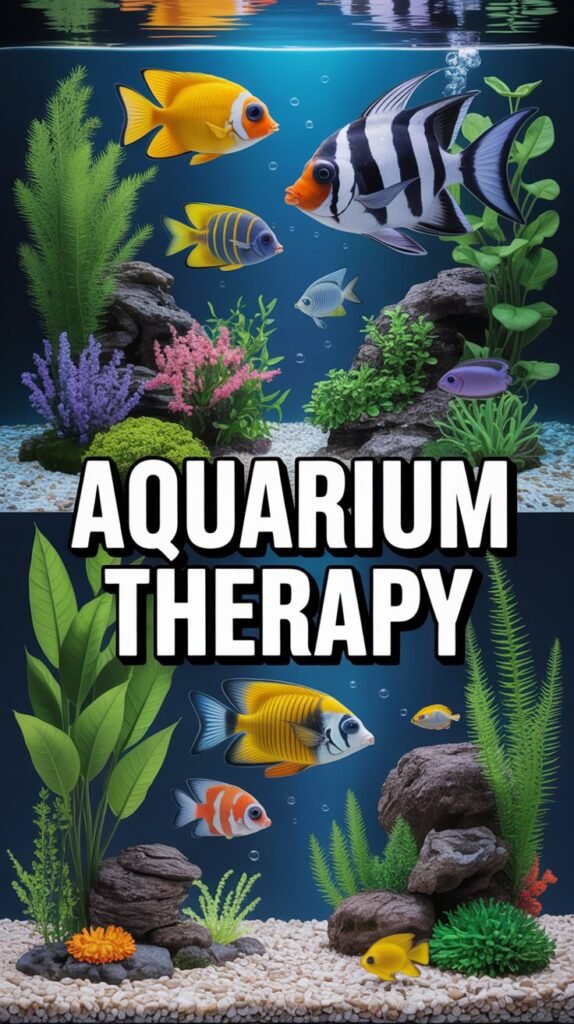In today’s fast-paced and stressful world, finding peace of mind has become a challenge for many. Between work pressure, social obligations, and constant digital noise, people are searching for ways to unwind and reconnect with calmness. One of the most underrated yet incredibly effective methods of relaxation is Aquarium Therapy—the art and science of using aquariums as a therapeutic tool for emotional, mental, and even physical well-being.
Aquarium therapy isn’t just about watching fish swim around in a tank; it’s a form of mindful observation that has measurable psychological and physiological benefits. From lowering blood pressure and reducing anxiety to improving focus and promoting emotional healing, the gentle flow of water and the rhythmic movement of fish create a soothing environment for the human mind.
In this comprehensive guide, we’ll explore what aquarium therapy is, how it works, its benefits, and how you can incorporate it into your daily life to improve your overall well-being.
What Is Aquarium Therapy?
Aquarium Therapy, also known as Aquatic Therapy for the Mind, refers to the therapeutic use of aquariums and aquatic environments to promote relaxation and mental health. It involves observing and interacting with aquariums—whether at home, in offices, hospitals, or therapy centers—to reduce stress, anxiety, and negative emotions.
The calming sounds of bubbling water, the fluid motion of fish, and the visual beauty of aquatic plants create a multisensory experience that engages both the mind and body. This interaction triggers a parasympathetic nervous response, the body’s natural relaxation mechanism, leading to a peaceful and meditative state.
Unlike traditional therapy sessions that require conversation or analysis, aquarium therapy works subtly, through visual and sensory stimulation, allowing individuals to relax effortlessly.
The Science Behind Aquarium Therapy

Numerous scientific studies have confirmed the relaxing power of aquariums. Research from institutions such as the National Marine Aquarium in the UK and various psychological studies have found that even short exposure to aquariums can result in lower heart rate, reduced blood pressure, and improved mood.
1. Visual Stimulation and Relaxation
The human brain responds positively to natural scenes. Watching colorful fish swimming gracefully in water creates a sense of harmony and balance. The slow, repetitive movements encourage mindfulness, which helps shift the brain from a state of overthinking to peaceful observation.
2. Sound Therapy from Water Movement
The gentle bubbling or flowing sound of aquarium water mimics the calming sounds of nature, which help induce relaxation. Sound therapy experts note that such natural water sounds can reduce insomnia, calm racing thoughts, and promote emotional balance.
3. Color Psychology in Aquariums
Colors play an important role in emotional regulation. The blue and green tones commonly found in aquariums are associated with peace, tranquility, and renewal. Brightly colored fish add joy and positive energy, enhancing mood and combating emotional fatigue.
4. Reduced Cortisol Levels
Studies show that aquarium therapy can reduce cortisol, the stress hormone. Spending even 10 minutes observing fish can significantly lower cortisol levels, helping people feel calmer and more focused.
Mental and Emotional Benefits of Aquarium Therapy
Aquarium therapy is often recommended by psychologists and therapists as a complementary treatment for mental and emotional well-being. Let’s explore the key benefits in detail.
1. Stress Relief
One of the most immediate effects of aquarium therapy is stress reduction. Watching fish glide gracefully through the water helps slow down your breathing and heart rate. This physical change signals your brain that it’s safe to relax, creating an instant sense of peace.
2. Reduced Anxiety and Depression
Aquariums promote mindfulness—the practice of being fully present in the moment. For those struggling with anxiety or depression, this can be a powerful grounding technique. The continuous movement and visual appeal help redirect thoughts from negative patterns toward calm observation.
3. Improved Focus and Attention
In environments such as classrooms or workplaces, aquariums have been shown to improve concentration and productivity. The calm and structured environment helps clear mental clutter, allowing for better cognitive performance.
4. Emotional Healing
For individuals going through grief, trauma, or emotional exhaustion, aquariums offer gentle comfort. The steady flow of water and the peaceful coexistence of aquatic life symbolize continuity and healing, making aquarium therapy a valuable emotional support tool.
5. Enhanced Mood and Happiness
Fish tanks can serve as natural mood boosters. The bright colors, soothing sounds, and living motion of aquatic life stimulate dopamine production—the feel-good chemical in the brain—enhancing happiness and emotional balance.
Physical Health Benefits of Aquarium Therapy

While aquarium therapy is primarily known for mental wellness, it also positively impacts physical health.
1. Lower Blood Pressure
Several clinical studies have proven that watching aquariums can lower blood pressure and heart rate. This makes it particularly beneficial for people with hypertension or cardiovascular concerns.
2. Better Sleep Quality
The relaxing environment created by an aquarium, especially with dim lighting and the soft hum of a filter, promotes deep, restful sleep. It helps reduce insomnia and encourages a consistent sleep routine.
3. Pain Management
Hospitals and dental clinics often keep aquariums in waiting rooms for a reason. Patients report less perceived pain and reduced anxiety before medical procedures when exposed to aquarium environments.
4. Strengthened Immune Response
Chronic stress weakens the immune system. By reducing stress and promoting relaxation, aquarium therapy indirectly supports a healthier immune function, making it easier for the body to fight off illness.
Aquarium Therapy in Different Settings
Aquarium therapy is versatile and can be integrated into a wide variety of settings for both individual and collective well-being.
1. Home Aquariums
At home, aquariums create a tranquil and aesthetic centerpiece. They serve as a personal sanctuary where one can unwind after a long day. Families also find aquariums educational and therapeutic for children, teaching them responsibility and empathy for living creatures.
2. Hospitals and Healthcare Centers
Hospitals use aquariums in waiting areas and recovery rooms to reduce patient anxiety and promote healing. Studies have shown that patients recovering in rooms with aquariums required fewer pain medications and reported greater satisfaction.
3. Offices and Workplaces
Aquariums in workplaces help reduce employee stress, increase creativity, and enhance focus. They also serve as attractive decor pieces that improve office ambiance and morale.
4. Schools and Therapy Centers
In classrooms, aquariums can help calm children with hyperactivity or autism spectrum disorders. In therapy centers, aquarium therapy supports emotional regulation and helps patients express themselves in non-verbal ways.
5. Elderly Care Homes
For the elderly, especially those with Alzheimer’s or dementia, aquarium therapy has proven to reduce agitation and improve appetite. The rhythmic movements of fish can spark memory and comfort feelings of loneliness.
How to Create Your Own Aquarium Therapy Space

Setting up an aquarium for therapeutic purposes doesn’t have to be complicated. With a few mindful choices, you can create a peaceful aquatic sanctuary in your home or workspace.
1. Choose the Right Aquarium Size
A medium-sized tank (20–40 gallons) is ideal for beginners. It’s large enough to support a balanced ecosystem and small enough for easy maintenance.
2. Select Peaceful Fish Species
Opt for calm and colorful fish like guppies, tetras, mollies, or angelfish. Avoid aggressive species that might create chaos in the tank, as this can disturb the peaceful atmosphere.
3. Add Live Plants
Aquatic plants such as Java Fern, Anubias, or Amazon Sword not only purify the water but also enhance the visual tranquility of the aquarium. The gentle sway of plants complements the soothing effect of fish movement.
4. Create Natural Lighting
Use soft, warm lighting to mimic natural sunlight. Avoid harsh or overly bright lights that can cause eye strain.
5. Include Calming Sounds
Choose an aquarium filter that produces a soft bubbling or trickling sound. This subtle background noise enhances the relaxing experience.
6. Keep It Clean and Balanced
A well-maintained aquarium reflects harmony and order. Regular cleaning and balanced water conditions ensure a healthy environment for fish and a stress-free experience for the observer.
Why Aquarium Therapy Works So Well
Aquarium therapy works because it taps into the fundamental human connection with nature. Watching fish swim is not just visually appealing—it activates biophilia, the natural human instinct to seek connection with other forms of life.
It also encourages mindfulness. In a world where distractions are constant, focusing on the simple movement of fish or the bubbles rising to the surface allows the brain to pause and recharge. Over time, this leads to better emotional resilience, improved mood, and a deeper sense of inner calm.
Tips for Maximizing the Benefits of Aquarium Therapy
- Spend at least 10–15 minutes daily observing your aquarium in silence.
- Practice deep breathing while watching the fish to enhance relaxation.
- Keep your aquarium in a quiet and visible area, such as your living room or workspace.
- Choose soothing colors for decorations—blue, green, and white tones are ideal.
- Pair your aquarium therapy sessions with soft background music or meditation for deeper calm.
- Avoid overstocking your aquarium to maintain harmony and reduce stress for the fish.
Conclusion
Aquarium therapy is more than just a hobby—it’s a holistic approach to improving mental, emotional, and physical health. The gentle rhythm of underwater life offers a unique kind of peace that modern living often lacks. Whether you’re looking to manage stress, improve focus, or simply find a few moments of tranquility each day, an aquarium can serve as your personal oasis of calm.
By integrating aquarium therapy into your life, you not only create a beautiful visual space but also invite balance, mindfulness, and serenity into your daily routine. In a world that never stops moving, the quiet dance of fish and the flow of water remind us that peace is always within reach—if we just take a moment to watch.
Frequently Asked Questions (FAQs)
1. What is aquarium therapy used for?
Aquarium therapy is used to reduce stress, anxiety, and depression while promoting relaxation, mindfulness, and emotional healing. It’s beneficial in homes, offices, hospitals, and therapy centers.
2. How long should I watch an aquarium to feel relaxed?
Even 10 minutes of watching fish can lower blood pressure and heart rate. For deeper relaxation, spend 20–30 minutes daily observing your aquarium.
3. Is aquarium therapy scientifically proven?
Yes. Multiple studies have shown that observing aquariums can reduce stress hormones, lower blood pressure, and improve mood.
4. What type of fish are best for relaxation?
Peaceful and colorful fish such as guppies, tetras, mollies, neon fish, and angelfish are ideal for a calming aquarium environment.
5. Can aquarium therapy help with insomnia?
Yes. The gentle sound and movement of water can relax the mind and help you fall asleep faster.
6. Is aquarium therapy suitable for children or the elderly?
Absolutely. Aquarium therapy benefits all age groups and is especially calming for children with ADHD and elderly individuals with dementia or anxiety.
7. How do I start aquarium therapy at home?
Begin by setting up a small, peaceful aquarium with soft lighting, calm fish, and live plants. Place it in a quiet area and spend time each day simply observing and breathing deeply.

